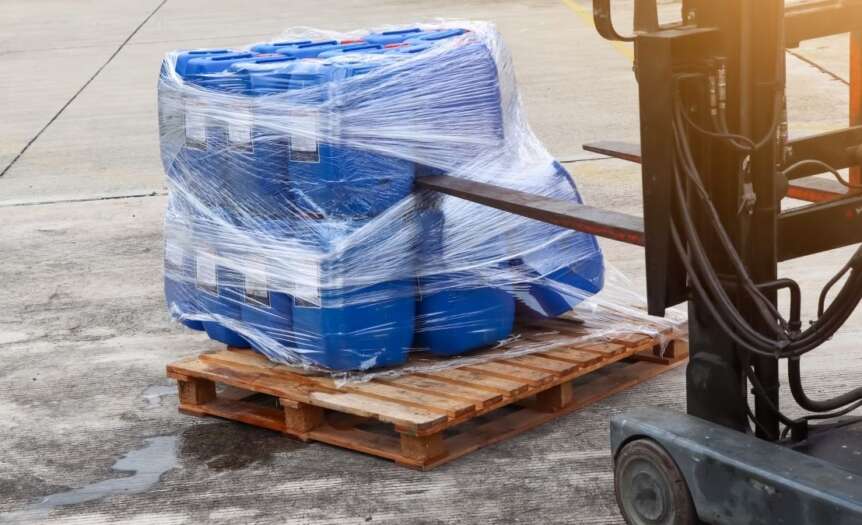Secondary packaging facilities and other material handling warehouses see a lot of movement every day. Products, heavy machinery, and employees move quickly throughout the facility to accomplish their tasks and achieve successful levels of productivity. With all that traffic and movement, it’s important to prioritize safety across the board. Create a healthier and happier work environment by learning how to avoid these common warehouse injuries.
Traffic Accidents
Forklift safety is essential for any warehouse that uses heavy machinery. Even minor accidents can result in injured employees, damaged equipment, and product losses. Fortunately, there are a few straightforward ways to minimize the risk of traffic accidents in your facility.
Start with your layout. Make sure your warehouse floor is clear, spacious, and well-lit, especially along the paths where your forklifts travel. If there are tight corners that forklift drivers might have trouble seeing around, place caution signs and traffic mirrors to help operators stay aware of their surroundings. You should also invest in routine training to ensure all forklift operators are up to date with safety procedures and other best practices.
Back Strain and Other Ergonomic Injuries
Not all injuries come from big accidents. In fact, ergonomic issues such as back pain or tendonitis are some of the most common warehouse injuries you want to avoid. Repetitive motion, muscle strain, and other side effects of common warehouse tasks take their toll on the body over time.
You can help employees stay healthy by providing training on proper ergonomics while on the job. Healthy lifting techniques, for example, can make a big difference for warehouse employees.
Another solution is to give physically strenuous tasks—like lifting or stacking heavy loads—to automated machinery. In fact, employee safety is one of the biggest reasons why automated solutions such as palletizers are worth the investment. When machines handle repetitive or strength-based tasks, employees can focus on much safer jobs in the warehouse.
Slips and Falls
Slips, trips, and falls are common injuries in any job. Luckily, there are plenty of ways to minimize hazards in your warehouse. Once again, it’s essential to keep the floor of your warehouse clear, clean, and well-lit. This reduces the number of tripping hazards your employees might come across.
Additionally, keep proper signage on hand to mark slipping or tripping hazards. Using wet floor signs, marking stairs or ramps with tape, and redirecting traffic when messes do occur are all effective ways to keep employees safe and aware on the warehouse floor.










 Deering Estate
Deering Estate
 Massage Envy South Miami
Massage Envy South Miami
 Calla Blow Dry
Calla Blow Dry
 My Derma Clinic
My Derma Clinic
 Sushi Maki
Sushi Maki
 Sports Grill
Sports Grill
 The Healthy Kitchen
The Healthy Kitchen
 Golden Rule Seafood
Golden Rule Seafood
 Malanga Cuban Café
Malanga Cuban Café

 Kathleen Ballard
Kathleen Ballard
 Panter, Panter & Sampedro
Panter, Panter & Sampedro
 Vintage Liquors
Vintage Liquors
 The Dog from Ipanema
The Dog from Ipanema
 Rubinstein Family Chiropractic
Rubinstein Family Chiropractic
 Your Pet’s Best
Your Pet’s Best
 Indigo Republic
Indigo Republic




 ATR Luxury Homes
ATR Luxury Homes


 2112 Design Studio
2112 Design Studio
 Hamilton Fox & Company
Hamilton Fox & Company
 Creative Design Services
Creative Design Services
 Best Pest Professionals
Best Pest Professionals
 HD Tree Services
HD Tree Services
 Trinity Air Conditioning Company
Trinity Air Conditioning Company
 Cisca Construction & Development
Cisca Construction & Development
 Mosquito Joe
Mosquito Joe
 Cutler Bay Solar Solutions
Cutler Bay Solar Solutions


 Miami Royal Ballet & Dance
Miami Royal Ballet & Dance
 Christopher Columbus
Christopher Columbus
 Pineview Preschools
Pineview Preschools
 Westminster
Westminster
 Carrollton
Carrollton
 Lil’ Jungle
Lil’ Jungle
 Frost Science Museum
Frost Science Museum
 Palmer Trinity School
Palmer Trinity School
 South Florida Music
South Florida Music
 Pinecrest Orthodontics
Pinecrest Orthodontics
 Dr. Bob Pediatric Dentist
Dr. Bob Pediatric Dentist
 d.pediatrics
d.pediatrics
 South Miami Women’s Health
South Miami Women’s Health

 The Spot Barbershop
The Spot Barbershop
 My Derma Clinic
My Derma Clinic




 Miami Dance Project
Miami Dance Project

 Rubinstein Family Chiropractic
Rubinstein Family Chiropractic
 Indigo Republic
Indigo Republic

 Safes Universe
Safes Universe
 Vintage Liquors
Vintage Liquors
 Evenings Delight
Evenings Delight





 Atchana’s Homegrown Thai
Atchana’s Homegrown Thai
 Baptist Health South Florida
Baptist Health South Florida

 Laser Eye Center of Miami
Laser Eye Center of Miami
 Visiting Angels
Visiting Angels
 OpusCare of South Florida
OpusCare of South Florida

 Your Pet’s Best
Your Pet’s Best





 HD Tree Services
HD Tree Services
 Hamilton Fox & Company
Hamilton Fox & Company


 Creative Design Services
Creative Design Services